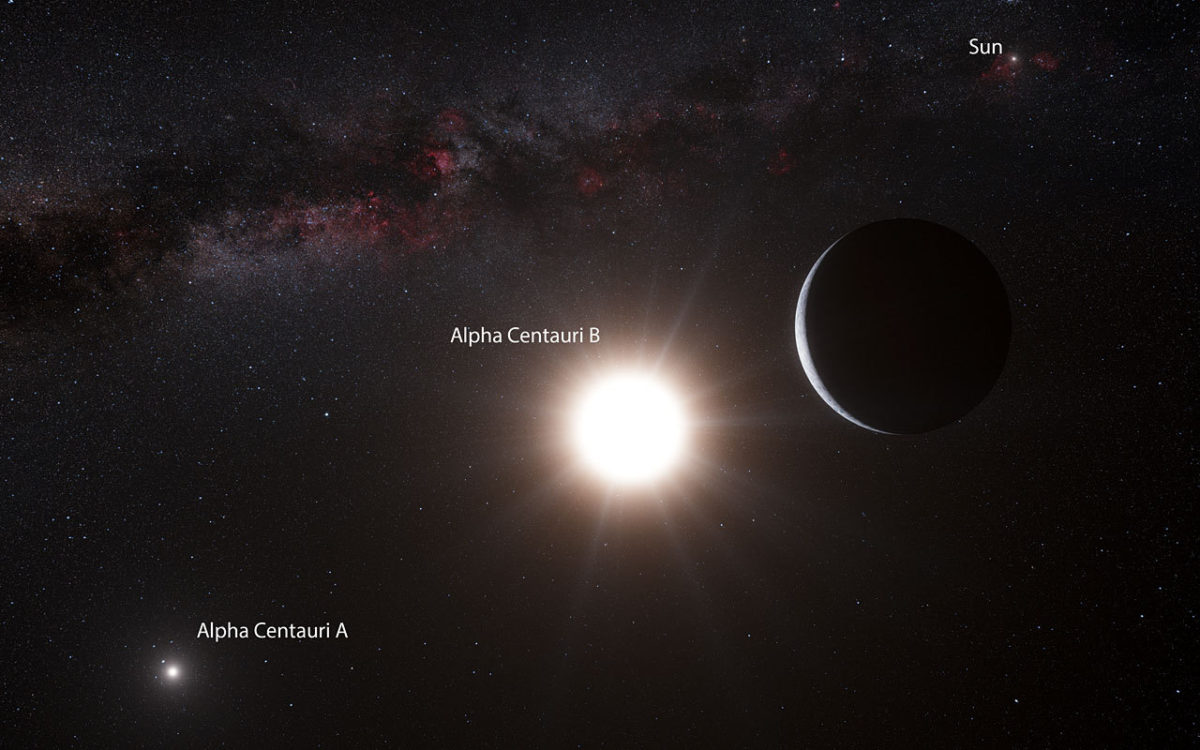Bruce Betts • Oct 17, 2012
First Planet Discovered in Alpha Centauri System
Using more than four years of data, astronomers using the HARPS instrument on the 3.6-meter telescope at ESO’s (European Southern Observatory) La Silla Observatory in Chile have reported the discovery of a slightly larger than Earth-mass planet orbiting the star Alpha Centauri B. This is the first discovery of a planet in our closest neighbor system of stars, and the least massive exoplanet ever discovered around a star like the Sun. I wanted to share with you some thoughts and insights by Yale astronomer Debra Fischer who leads another Alpha Centauri planet search that is partially supported by The Planetary Society. But first, here is a little more on the discovery (and if you are looking for a primer on exoplanet hunting, check out our online astronomy course lecture on the subject).

The planet would be crispy, toasty hot (not a technical term), at least on the side facing its parent star, since it orbits only 6 million kilometers from its parent star in a 3.2 day orbit. For comparison, the closest point to the Sun in Mercury’s elliptical orbit is 46 million kilometers, and Mercury has an 88 day orbit.
The European discovery team’s research was published today in the journal Nature. The lead author is Xavier Dumusque (Observatoire de Genève, Switzerland; Centro de Astrofisica da Universidade do Porto, Portugal).
The Alpha Centauri system, a little over 4 light years away, consists of three stars labeled A, B, and C from brightest to dimmest. The two brightest are roughly Sun-like, whereas the third, also known as Proxima Centauri because it is the closest to Earth, is a red dwarf much farther out in the system. The planet discovery was around Alpha Centauri B (AlphaCenB, or aCenB or Scooter [not really]), which is somewhat smaller and less bright than the Sun.
The Planetary Society is supporting another Alpha Centauri exoplanet search, led by Debra Fischer at Yale University (read about it here and/or listen to Debra on Planetary Radio here). Debra shared with me her thoughts and some insights on the Alpha Cen planet discovery, as well as how it relates to their search:
“The HARPS team called me a week ago to let me know about their result and we've been analyzing our data and running simulations to test the detectability of this tiny signal. Our best data set for aCenB begins in June 2012, when we completed some stability upgrades to the new spectrograph (CHIRON) that we built for the 1.5-m CTIO telescope (with NSF MRI funding). Our precision since the upgrade matches the HARPS precision, but yields a 5-month string of data compared to the 5-year time baseline of data from HARPS.
There is not a more exciting result for an individual star, even with the long line of spectacular results from the last 2 decades. The indication that our nearest neighbor has rocky planets is incredible. Furthermore, statistical results from the NASA Kepler mission suggest that where there is one, there are usually several rocky planets. This leaves open the possibility of a terrestrial planet in the habitable zone - in fact, I think this strengthens the speculative possibility of a habitable world in the alpha Cen system.
The Geneva team has done something very difficult, but it's an approach that I've advocated for the past few years: they are digging into their data to remove signals that arise from the surface of the star, leaving behind the whiff of a residual signal - a mere 0.5 m/s - induced by a prospective planet. The team is extremely careful and no one wants to be wrong about such a high profile result. I have no doubt that they have carried out every reasonable test of their data before making this announcement. Nevertheless, because these corrections essentially constitute a new approach, confirmation is critical. We are in an excellent position to follow-up, but that will likely require an intensive search over the prospective orbital period of 3.24d when the star rises again in January 2013.”
The first discovery of another world, much less an Earth-sized world around a star in the closest star system to Earth is a profound one, and one that is all the more exciting because, it may portend future discoveries there of planets that are even more Earth-like. Even around our nearest neighbors, the search is not easy, but the results may yield planets we can study in more depth because of their “closeness.” Someday, Alpha Centauri planets could be the first extra-solar system destination for advanced future robotic and, maybe someday, human emissaries.
The Time is Now.
As a Planetary Defender, you’re part of our mission to decrease the risk of Earth being hit by an asteroid or comet.
Donate Today

 Explore Worlds
Explore Worlds Find Life
Find Life Defend Earth
Defend Earth

